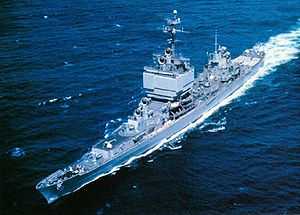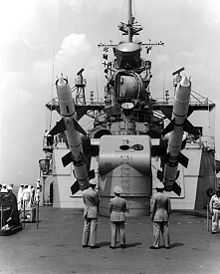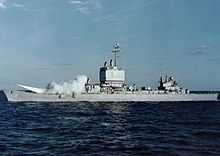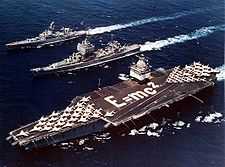USS Long Beach (CGN-9)
 USS Long Beach | |
| Career (US) | |
|---|---|
| Name: | Long Beach |
| Namesake: | Long Beach, California |
| Ordered: | 15 October 1956 |
| Builder: | Bethlehem Steel Co., Fore River Shipyard, Quincy, Massachusetts |
| Laid down: | 2 December 1957 |
| Launched: | 14 July 1959 |
| Sponsored by: | Mrs. Craig Hosmer |
| Acquired: | 1 September 1961 |
| Commissioned: | 9 September 1961 |
| Decommissioned: |
1 May 1995 (deactivated on 2 July 1994) |
| In service: | 0 |
| Out of service: | 1 |
| Reclassified: | as CGN-9 1 July 1958 |
| Struck: | 1 May 1995 |
| Fate: |
Superstructure and Nuclear Reactor recycled at Puget Sound Naval Shipyard 25 September 2002. Hull auctioned for scrap to Tacoma Metals on 12 July 2012 for around $900,000 |
| General characteristics | |
| Class and type: | Long Beach-class cruiser |
| Displacement: | 15,540 tons |
| Length: | 721 ft 3 in (219.84 m) |
| Beam: | 71 ft 6 in (21.79 m) |
| Draft: | 30 ft 7 in (9.32 m) |
| Propulsion: | 2 C1W nuclear reactors; 2 General Electric turbines; 80,000 shp (60 MW); 2 propellers |
| Speed: | 30 knots (56 km/h) |
| Range: | Nuclear |
| Complement: | 1160 officers and men |
| Sensors and processing systems: | 1 AN/SPS-10 surface search radar[1] AN/SPS-12 search radar[1] AN/SPS-32 bearing and range radar[1] AN/SPS-33 target tracking radar[1] AN/SPS-48 3D air search radar AN/SPS-49 2D air search radar 2 AN/SPG-49 Talos fire control radar[1][2] 4 AN/SPG-55 Terrier fire control radar[1][2] AN/SQS-23 SONAR[1] |
| Electronic warfare and decoys: | AN/SLQ-32 |
| Armament: | Two twin Terrier guided-missile launchers One twin Talos missile launcher (later removed) One 8-cell ASROC launcher Two 5 inch guns Two triple 12.75 inch ASW torpedo tubes launchers for 8 Harpoon missiles added later two Armored Box Launchers for a total of eight Tomahawk cruise missiles replaced the Talos launcher |
| Aircraft carried: | None. landing pad available for one helicopter |
| Motto: | "Strike Hard, Strike Home" |
USS Long Beach (CLGN-160/CGN-160/CGN-9) was a nuclear-powered guided missile cruiser in the United States Navy. She was the only ship of her class.
Long Beach was the first "all-new" cruiser designed and constructed after World War II (all others were completions or conversions of cruisers begun or completed during the war.) She was the third Navy ship named after the city of Long Beach, California, and the last ship built on a traditional "cruiser hull" in the U.S. Navy; all subsequent cruisers were built on scaled-up destroyer hulls. This led to the slogan she carried in her later years: "The Only Real Cruiser."
Long Beach was decommissioned in 1995 and was scrapped at Puget Sound Naval Shipyard.
Configuration

The ship was designed as an "all-missile" ship from the very beginning, but was fitted with two 5"/38 caliber gun mounts amidships on the orders of President Kennedy. Long Beach was also the last cruiser built on a traditional long, lean cruiser hull; later new-build cruisers were actually converted frigates (DLG/CG USS Leahy (DLG-16), USS Bainbridge (DLGN-25), USS Belknap (DLG-26), USS Truxtun (DLGN-35), and the California and Virginia classes) or uprated destroyers (the DDG/CG Ticonderoga class was built on a Spruance class destroyer hull).
Long Beach was first laid out to be a smaller frigate, but expanded to a cruiser hull due to the ship being slated for the Regulus nuclear cruise missile or, later, 4 launching tubes for the Polaris missile, which would occupy the space taken up by the 5"/38 caliber gun mounts and the ASROC system. The open space just aft of the bridge "box" was to be the area for these.
In addition to steel, Long Beach was built with 450 tons of structural aluminum.[3] Because of this unusually high quantity of aluminum, she was assigned the voice radio call sign "Alcoa".[3]
The ship was propelled by two nuclear reactors, one for each propeller shaft, and was capable of speeds in excess of 30 knots (56 km/h). The high box-like superstructure contained the SCANFAR system, consisting of the AN/SPS-32 and AN/SPS-33 phased array radars. One of the reasons Long Beach was a one-ship class was because it was an experimental platform for these radars, which were precursors to the AN/SPY-1 phased array systems later installed on Aegis warships (Ticonderoga-class cruisers and Arleigh Burke-class destroyers). At the time, Long Beach had the highest bridge of any ship smaller than an aircraft carrier.
Weapons suite
The original weapons suite consisted of:
- Talos Long Range Surface-to-Air Missiles (SAM) with a range in excess of 80 nmi (150 km).
- Terrier Medium Range SAMs with a range in excess of 30 miles (48 km).
- ASROC system capable of delivering a torpedo or depth charge at a range of 10,000 yd (9.1 km).
- Two twin 12.75 inch torpedo launchers that could fire the Mark 46 torpedo.
- Two 5"/38 caliber gun, capable of surface and shore bombardment to a range of 18,000 yd (16 km).
The ship went through several modifications by the time she was decommissioned. The final weapons suite consisted of:
- Two forward launchers for the Standard extended range missiles. These replaced the Terrier and the Talos.
- The rear launcher for the Talos was replaced with 2 BGM-109 Tomahawk cruise missile box launchers. Each launcher held 4 missiles.
- Two Phalanx CIWS were added aft of aft mast.
- Two RGM-84 Harpoon ship-to-ship missile launchers were added. Each launcher held 4 Harpoons.
The 5"/38's and the ASROC were retained, and several 12.7mm (50-cal) were installed as needed.
 RIM-8 Talos missile launcher on USS Long Beach, July 1961 |
 RIM-2 Terrier missile launch from USS Long Beach, October 1961 |
History
Long Beach was originally ordered as CLGN-160. She was reclassified CGN-160 in early 1957, but was again reclassified as CGN-9 on 1 July 1957. Her keel was laid down on 2 December 1957 by Bethlehem Steel Co., Fore River Shipyard, Quincy, Massachusetts. She was launched 14 July 1959, sponsored by the wife of Craig Hosmer, Congressman from California. She was commissioned on 9 September 1961, with Captain Eugene P. Wilkinson in command.
Long Beach served in the Atlantic Fleet from her commissioning in 1961 until completing her first refueling in early 1966, when the cruiser was transferred from the home port of Norfolk, Virginia to Long Beach, California.

In May 1964, Long Beach joined the aircraft carrier USS Enterprise (CVN-65) and the guided missile destroyer USS Bainbridge (DLGN-25) to form the all-nuclear-powered Task Force 1. At the end of July, the three warships began Operation Sea Orbit, a two-month unrefueled cruise around the world. It was the first all-nuclear battle formation in the history of naval operations.
In October 1966, Long Beach deployed for the first of a number of cruises to the Western Pacific. During this initial cruise, the cruiser served primarily as the Positive Identification Radar Advisory Zone (PIRAZ) unit in the northern Gulf of Tonkin. As such, her main responsibility was to "sanitize" returning US air strikes, ensuring that no enemy aircraft were attempting to evade identification by hiding amongst returning friendlies. Additionally, the ship provided support for an on-board Search and Rescue (SAR) helicopter unit. During this tour, Long Beach was responsible for directing the downing of one Soviet-made An-2 'Colt' aircraft that was attempting to engage South Vietnamese naval units. The shoot-down was executed by an F-4 Phantom II fighter under the control of a Long Beach Air Intercept Controller (AIC). The cruiser returned to Long Beach, California, in July 1967, and was redeployed to the Gulf of Tonkin in 1968, shooting down a MiG fighter plane with a RIM-8 Talos missile in May 1968, at a range of 65 miles. She was the first ship to down an aircraft using SAMs. In September of the same year, she downed another MIG, this one at 61 miles. She also directed other MIG kills by American fighters.
.jpg)
After Vietnam Long Beach performed routine duties in the Western Pacific and Indian Ocean, although in 1975 she served escort duties for an ad-hoc U.S. task force during the Mayagüez incident. Around this time, Long Beach was identified as being suitable for conversion to accommodate the newly developed Aegis combat system, as part of the plans for a force of nuclear powered Aegis cruisers.[4] When the Talos missile system was removed in 1978 two 4-cell Harpoon anti-ship missile launchers were installed aft. In 1980 the vessel rescued 114 Vietnamese boat people off the coast of Vietnam. In 1979, and again from 1980 to 1983, Long Beach returned to Puget Sound to undergo a mid-life conversion, during which time the Billboard radars were removed from the forward superstructure and enhanced flagship facilities installed, along with modern radars. The Standard SM-2ER missiles and the associated modern electronics replaced the obsolete Terrier system. In addition, two 4-cell launchers and fire control for BGM-109 Tomahawk cruise missiles, two Phalanx close-in weapons CIWS were installed, and the Harpoon anti-ship missile SSM launchers were re-sited. Long Beach deployed throughout the 1980s, conducting Tomahawk cruise missile test launches, serving as an escort for the USS Missouri task force, and providing aircraft carrier escort support during the Gulf War of 1991.
Due to cuts in the defense budget after the First Gulf War, the decision was made to decommission all nuclear cruisers from the Navy as their reactor cores ran down. As Long Beach had been refueled during her 1970 refit, her third refueling was due in the early to mid-1990s. As a consequence, a decision was taken to decommission her in 1994.
A deactivation ceremony occurred on 2 July 1994 at Norfolk Naval Station, and the ship was then towed over to Newport News Shipbuilding where her entire superstructure was removed and her reactors were defueled and removed, along with any radioactive parts. After this work was completed in the winter of 1995 the hull was towed through the Panama Canal to Puget Sound Naval Shipyard. Long Beach was stricken on 1 May 1995, over 33 years after she had entered service.
On July 13, 2012, Long Beach was sold [5] for recycling as prescribed for nuclear-powered vessels by Code 350 of Puget Sound Naval Shipyard, Bremerton, Wash.
Milestones
_stbd_beam_view.jpg)
- 2 December 1957 — Keel laid in Bethlehem Steel Company's Fore River Shipyard, Quincy, Massachusetts.
- 14 July 1959 — launching; Mrs. Craig Hosmer christened the ship as her sponsor.
- 5 July 1961 — USS Long Beach underway for the first time using her own nuclear power.
- 9 September 1961 — USS Long Beach is commissioned as the first nuclear-powered surface vessel at the Boston Naval Shipyard.
- 2 October 1961 — Change of Home port to Norfolk, Virginia.
- 1 August 1963 — 1st deployment to the Mediterranean
- 28 April 1964 — 2nd deployment to the Mediterranean for "Nuclear Task Force One".
- 15 March 1966 — USS Long Beach and City of Long Beach, California unite for first time.
- 7 November 1966 — 1st West Pac deployment.
- 1 May 1967 — Deployed to Gulf of Tonkin.
- 9 December 1967 — Present at Long Beach to welcome RMS "Queen Mary" on her first call ever to her new home port.
- 15 April 1968 — 2nd West Pac deployment.
- 11 August 1969 — 3rd West Pac deployment.
- 1 July 1970 — USS Long Beach begins refueling at Mare Island Naval Shipyard.
- 28 March 1972 — 4th West Pac deployment.
- 1 May 1973 — 5th West Pac deployment.
- 7 November 1974 — 6th West Pac deployment.
- 7 June 1975 — Change of homeport to San Diego, California.
- 15 September 1976 — 7th West Pac deployment.
- 4 April 1978 — 8th West Pac deployment.
- 7 January 1980 — 9th West Pac deployment.
- 6 October 1980 — Begins Comprehensive Overhaul Puget Sound Naval Shipyard.
- 13 January 1984 — 10th West Pac deployment.
- 9 January 1985 — Selected Restricted Availability at Bremerton, Washington.
- 13 May 1986 — 11th West Pac deployment.
- 25 July 1987 — 12th West Pac deployment.
- 19 October 1987 — Participated in Kuwaiti tanker reflagging and provided anti-aircraft cover during Operation Nimble Archer.
- 13 October 1988 — North Atlantic Treaty Organization Ship Visit.
- 18 September 1989 — 13th West Pac deployment/world cruise.
- 28 May 1991 — 14th West Pac deployment in support of Operation Provide Comfort.
- 8 April 1992 — Comprehensive overhaul, Puget Sound Naval Shipyard.
- 12 May 1993 — Underway Counter Narcotics Patrol, Central America.
- 8 November 1993 — Underway Counter Narcotics Patrol, Caribbean.
- 6 May 1994 — Change of homeport to Norfolk, Virginia.
- 2 July 1994 — Deactivation ceremony, Norfolk Naval Station.
- 20 March 1995 — Removal of superstructure, reactors and radioactive parts completed.
- 13 July 2012 — Sold by auction[5] for scrap, Bremerton, WA.
Commanders
- 9 September 1961 – 11 September 1962: Captain Eugene P. Wilkinson
- 11 September 1962 – 23 August 1966: Captain F. H. Price
- 23 August 1966 – 15 June 1968: Captain K. C. Wallace
- 15 June 1968 – 25 September 1972: Captain William A. Spencer
- 25 September 1972 – 24 October 1975: Captain F. R. Fahland
- 24 October 1975 – 18 July 1978: Captain Harry C. Schrader
- 18 July 1978 – February 1982: Captain E. B. Bossart
- February 1982 – 1985: Captain F. Triggs
- February 1985 – September 1988: Captain M. J. Weniger
- September 1988 – November 1990: Captain J. C. Pollock, III
- November 1990 – April 1993: Captain W. R. Burns, Jr.
- April 1993 – July 1994: Captain K. P. Bersticker
Awards
|
||
|
| |
|
|
|
| Combat Action Ribbon | Joint Meritorious Unit Award with 1 star |
Navy Unit Commendation |
| Meritorious Unit Commendation with 1 star |
Navy E Ribbon with wreathed Battle "E" Device |
National Defense Service Medal with 1 star |
| Armed Forces Expeditionary Medal with 1 star |
Vietnam Service Medal with 6 stars |
Southwest Asia Service Medal with 1 star |
| Humanitarian Service Medal | Sea Service Deployment Ribbon | Special Operations Service Ribbon |
| Vietnam Campaign Medal | Kuwait Liberation Medal (Saudi Arabia) | Kuwait Liberation Medal (Kuwait) |
- 1 September 1987 – 2 September 1987
- 20 September 1987 – 26 September 1987
- 29 September 1987 – 28 October 1987
- 30 October 1987 – 29 November 1987
- 17 January 1990 – 31 January 1990
- 26 April 1972
- 29 April 1980
- 1 May 1980
- 16 October 1990 – 18 November 1990
- 10 June 1991 – 28 June 1991
- 19 November 1966 – 8 June 1967
- 10 April 1972 – 30 November 1972
- Battle Efficiency Award
- 1 July 1977 – 31 December 1978
- 1 January 1985 – 30 June 1986
- 1 July 1986 – 31 December 1987
- 1 January 1988 – 30 June 1989
- 1 January 1991 – 31 December 1992
- 1 January 1993 – 31 December 1993
- 7 May 1968 – 20 October 1968
- 10 April 1972 - 30 November 1972
- 15 November 1993
- 6 July 1991 – 12 October 1991
- 29 November 1966 – 6 January 1967
- 1 February 1967 – 1 March 1967
- 12 March 1967 – 7 April 1967
- 5 May 1967 – 13 June 1967
- 4 May 1968 – 11 June 1968
- 21 June 1968 – 11 July 1968
- 13 July 1968 – 7 August 1968
- 12 September 1968 – 23 October 1968
- 3 September 1969 – 11 October 1969
- 26 October 1969 – 4 December 1969
- 10 December 1969 – 12 December 1969
- 20 December 1969 – 22 December 1969
- 1 January 1970 – 25 January 1970
- 13 April 1972 – 23 June 1972
- 1 July 1972 – 31 July 1972
- 8 August 1972 – 6 September 1972
- 15 September 1972 – 16 October 1972
- 25 October 1972 – 22 November 1972
References
- ↑ 1.0 1.1 1.2 1.3 1.4 1.5 1.6 Blackman, Raymond V. B. Jane's Fighting Ships (1970/71) p.425
- ↑ 2.0 2.1 Polmar, Norman "The U.S. Navy: Shipboard Radars" United States Naval Institute Proceedings December 1978 p.144
- ↑ 3.0 3.1 USS Long Beach Association. "CGN-9 VITAL STATISTICS". USS Long Beach Association. 2003. Retrieved September 19, 2012.
- ↑ "CGN 9 Long Beach - Program". GlobalSecurity.org. Retrieved 24 September 2014.
- ↑ 5.0 5.1 Censer, Marjorie (18 September 2012). "Historic nuclear cruiser headed to scrap heap". The Washington Post. Retrieved September 18, 2012.
External links
| Wikimedia Commons has media related to USS Long Beach (CGN-9). |
- USS Long Beach Reunion Web Page
- Unofficial USS Long Beach webpage
- DANFS: Long Beach (CGN-9)
- Naval Vessel Register - CGN-9
- navsource.org: USS Long Beach
| ||||||||||||||
Coordinates: 47°33′16″N 122°38′26″W / 47.55444°N 122.64056°W